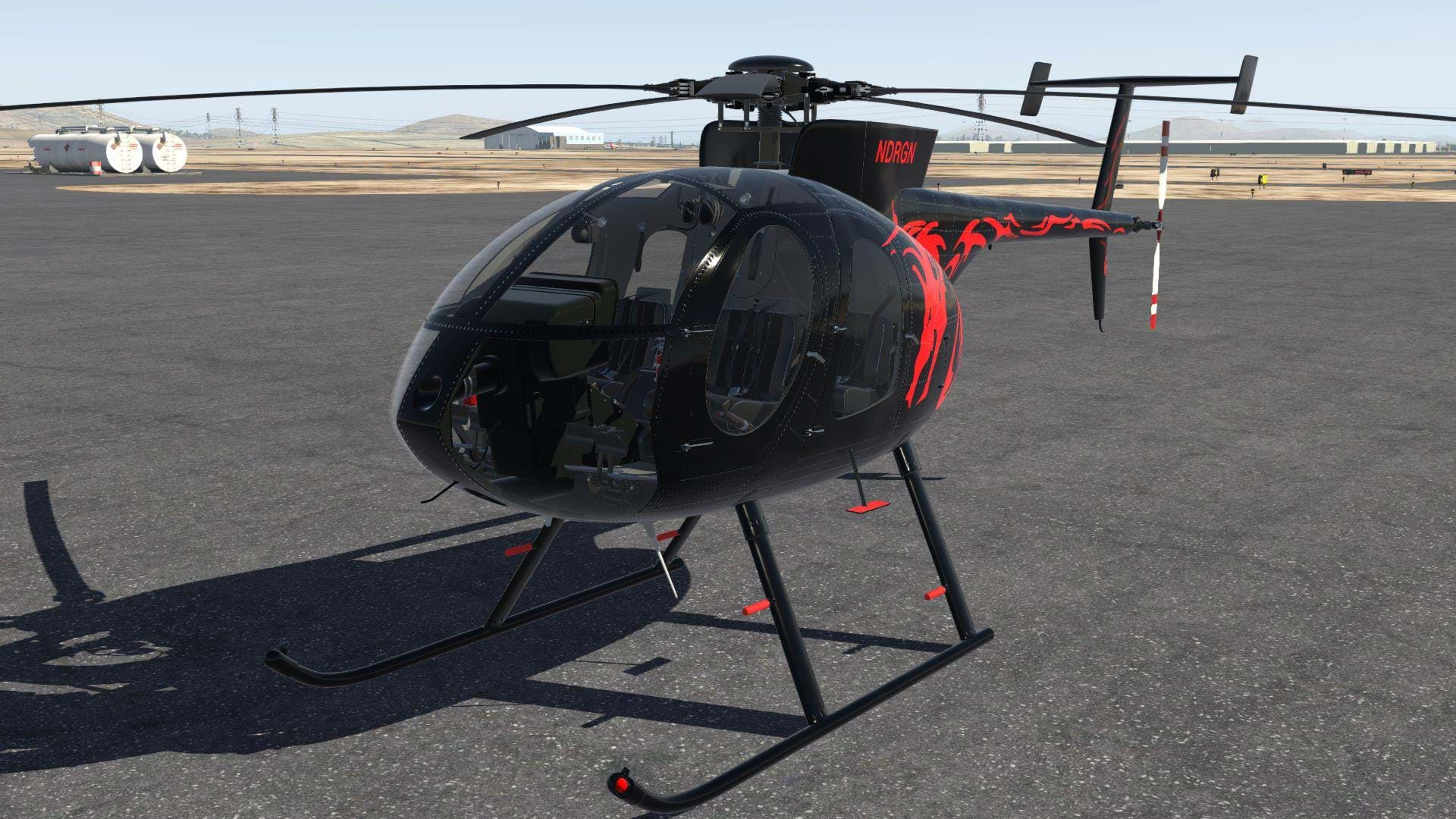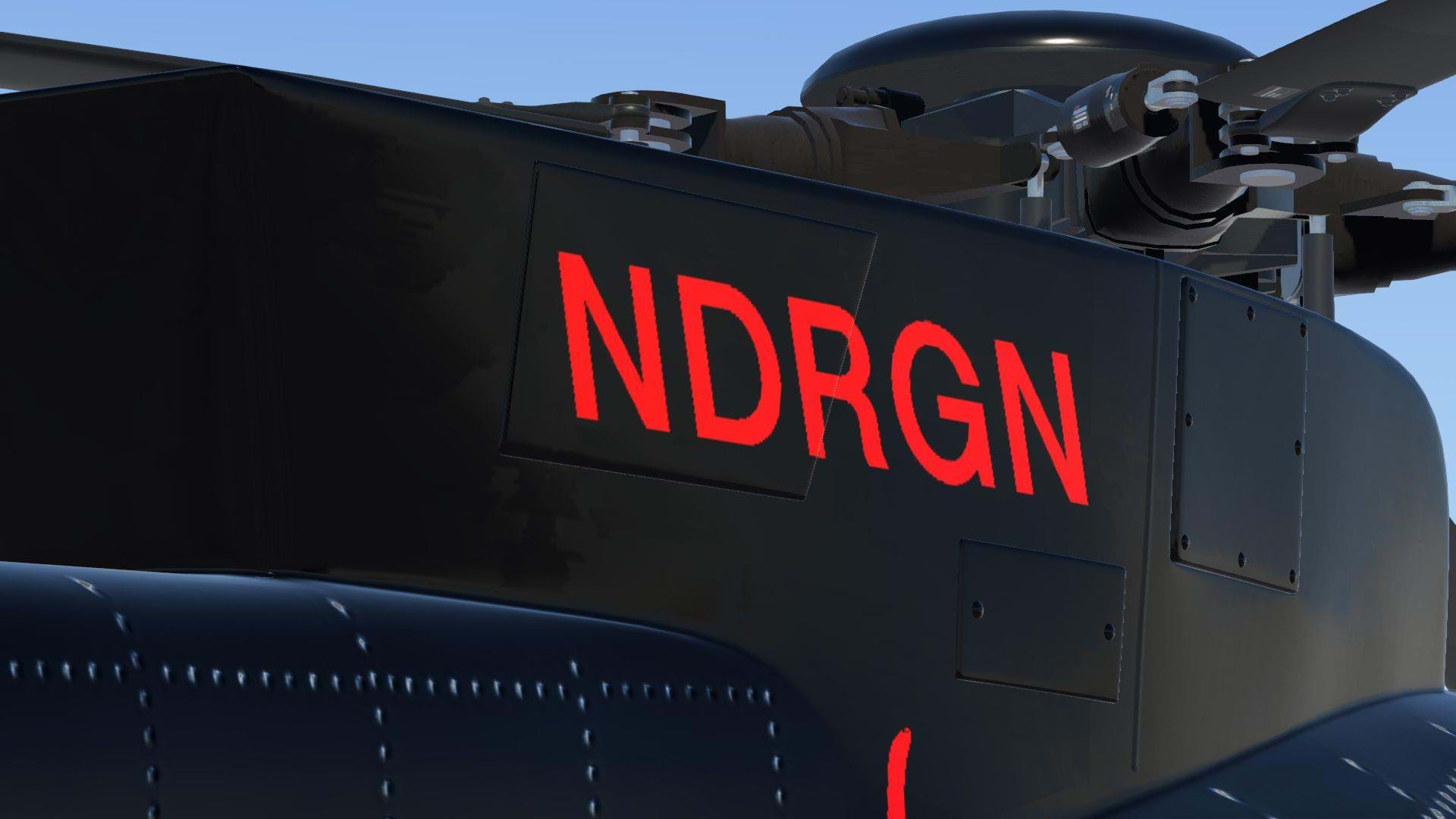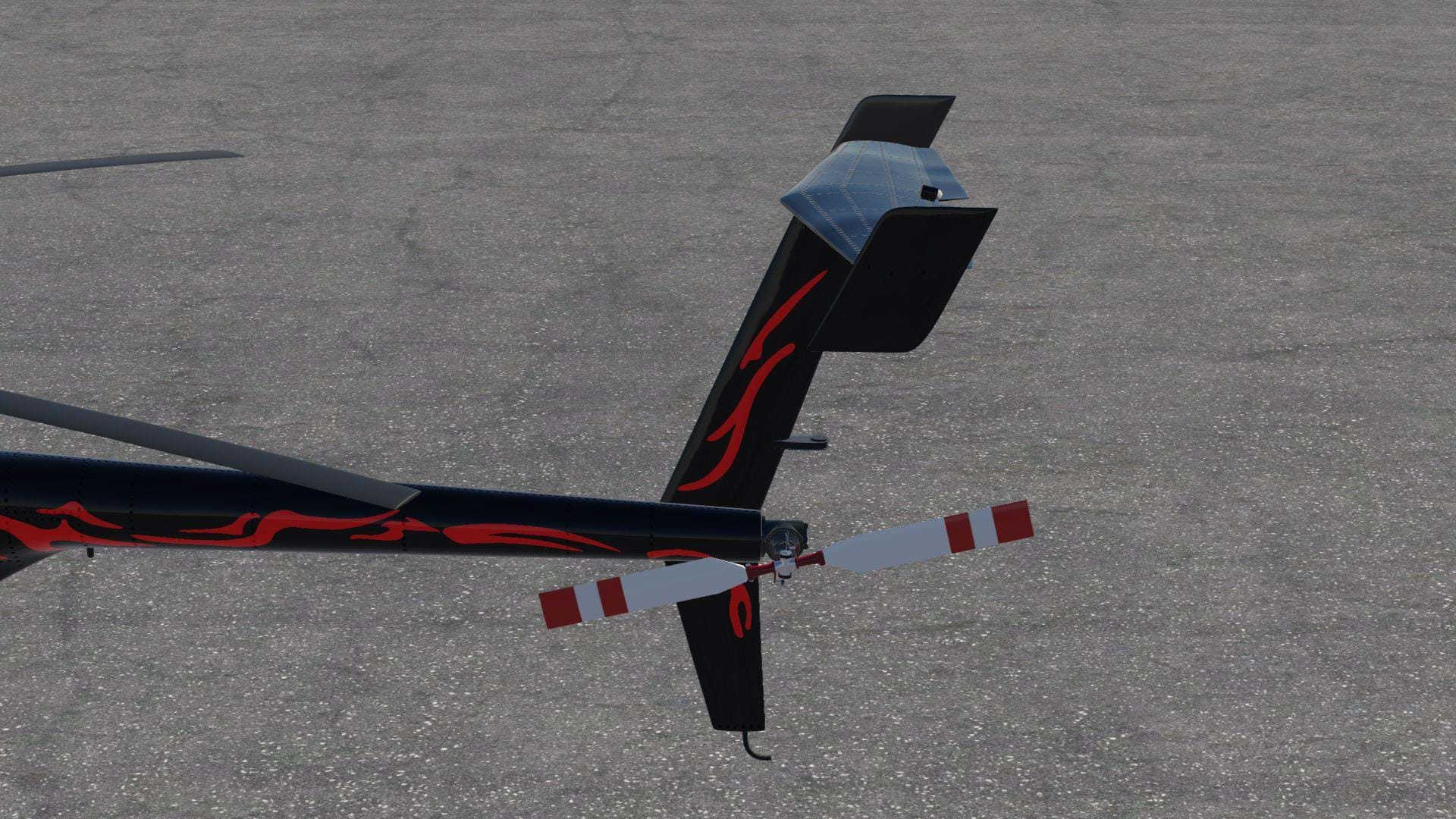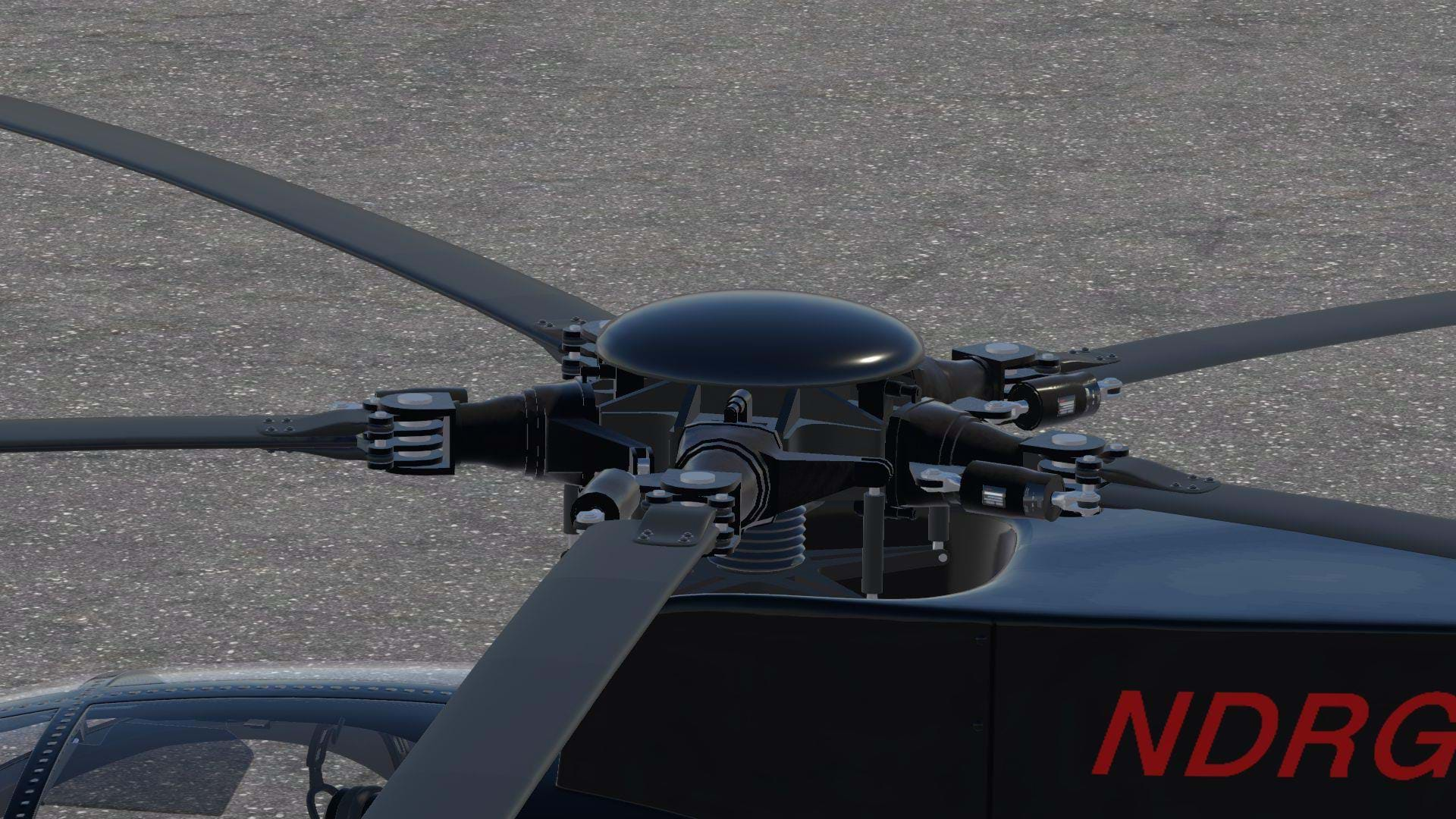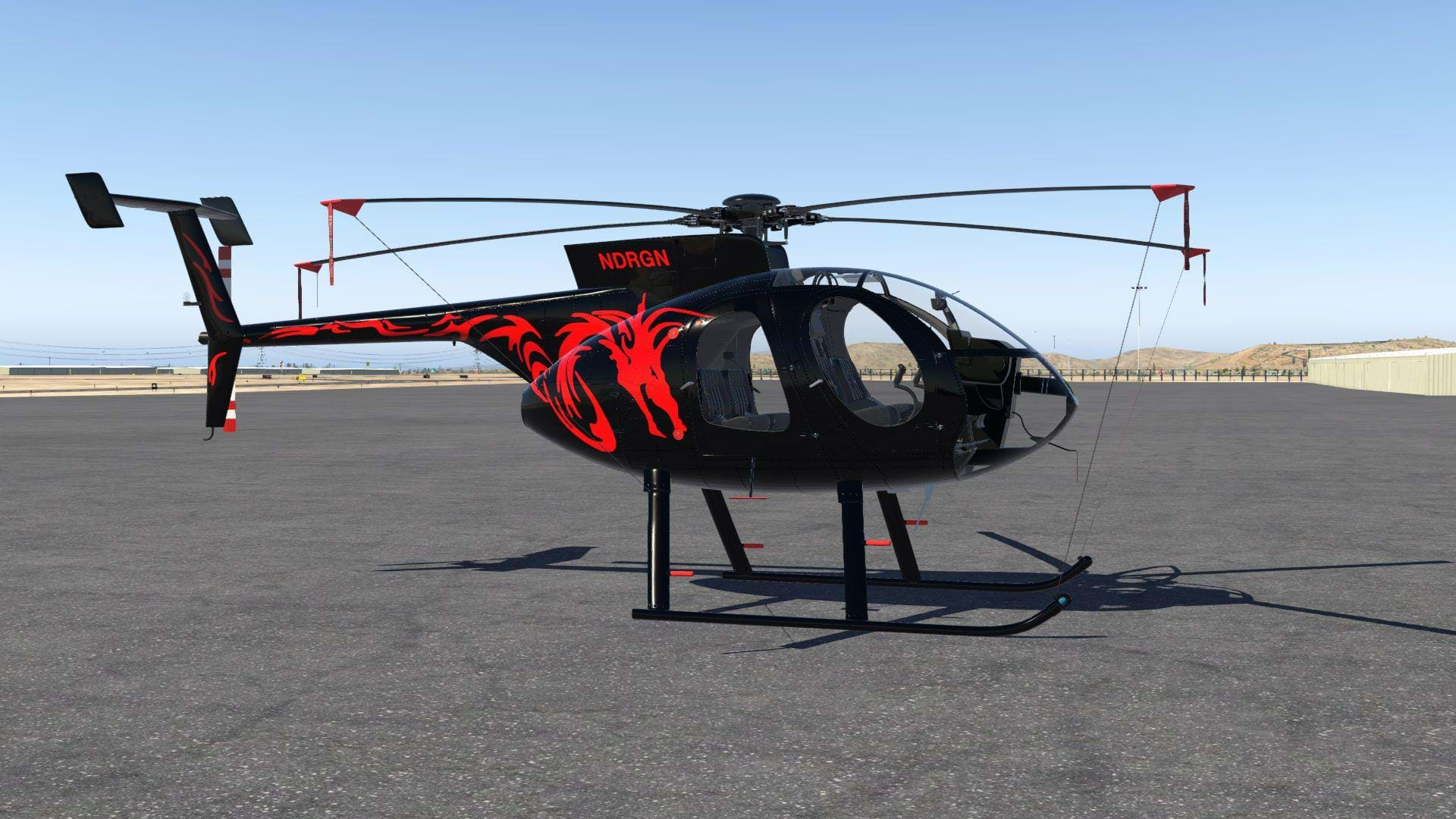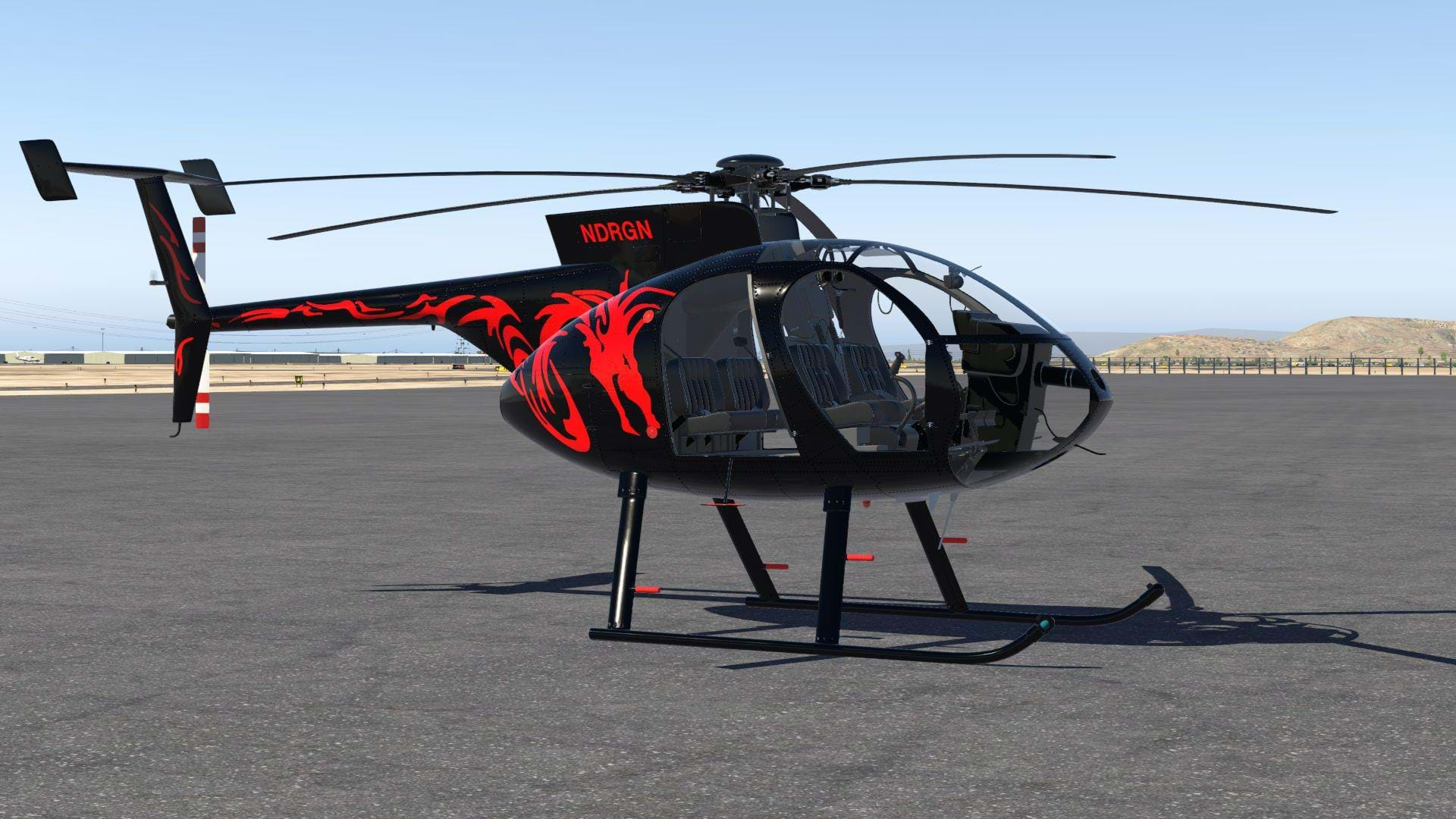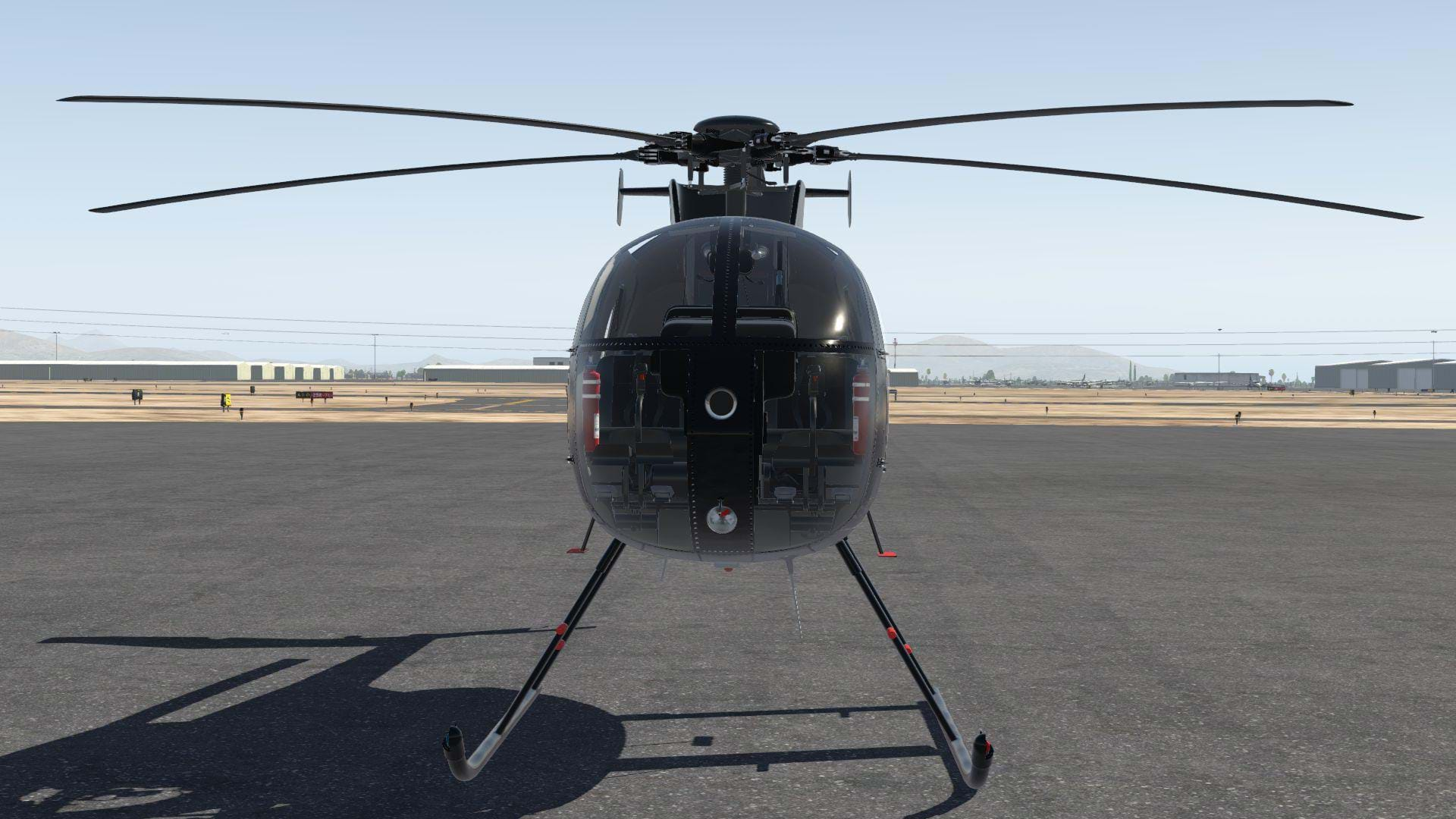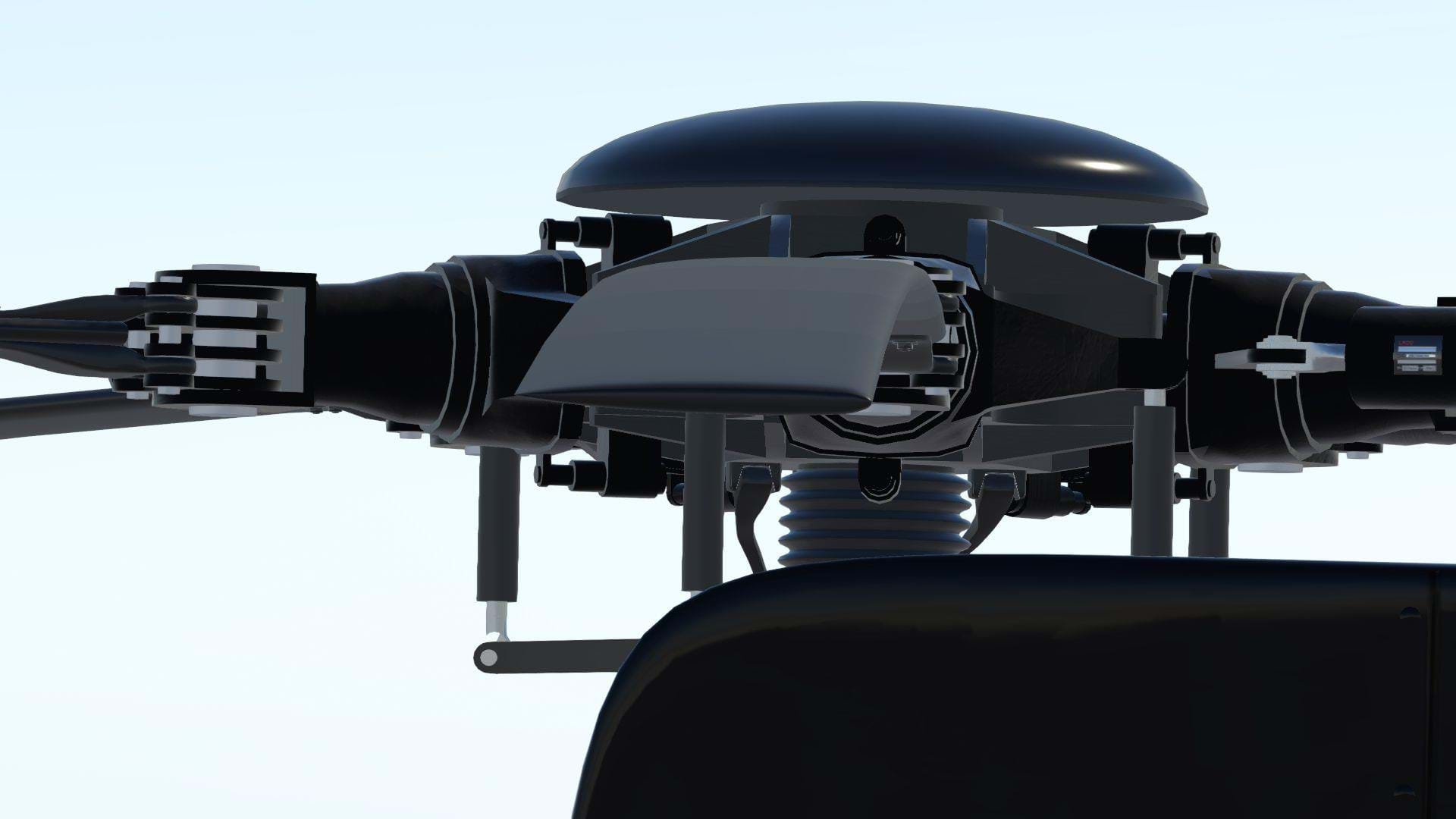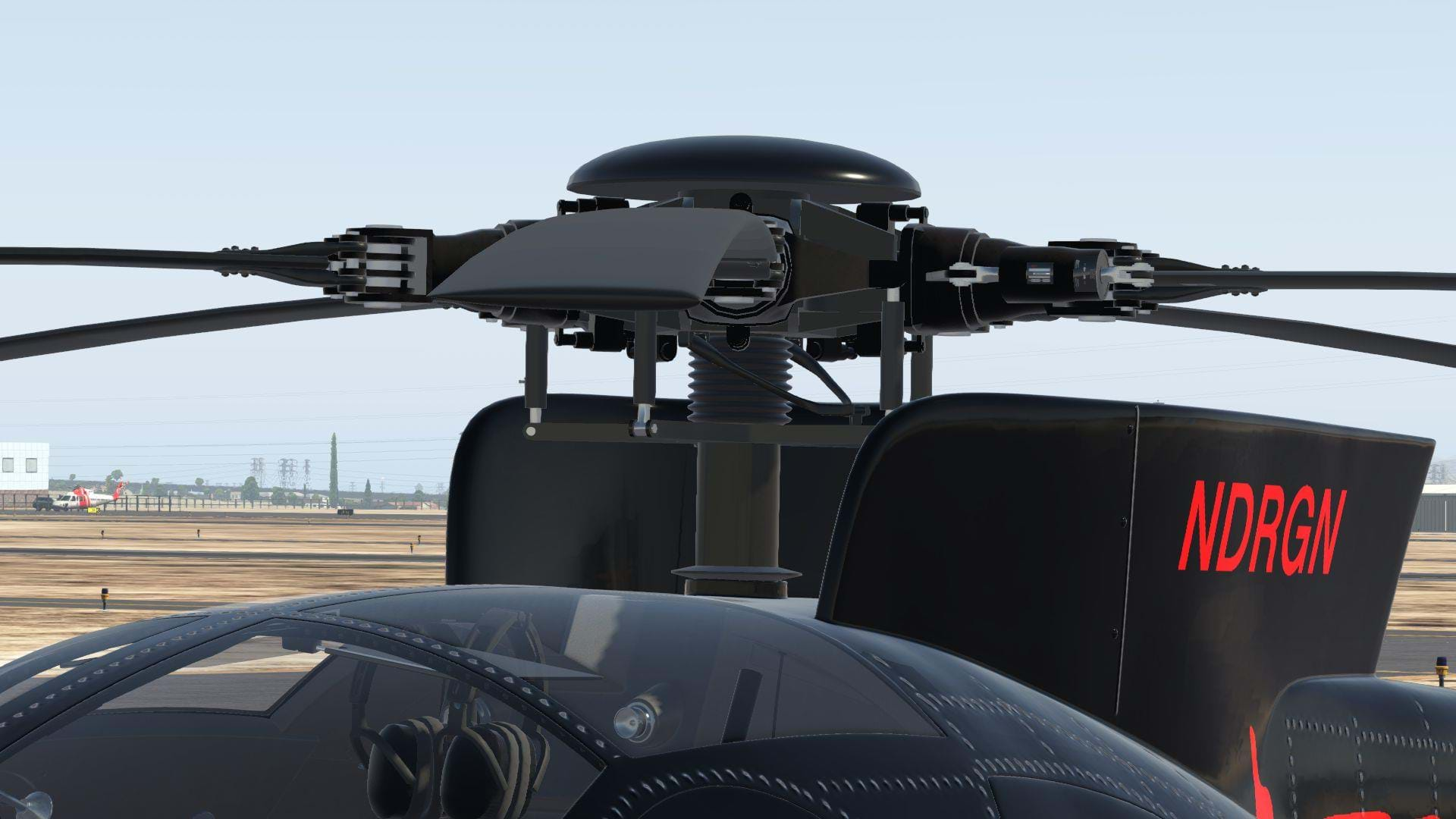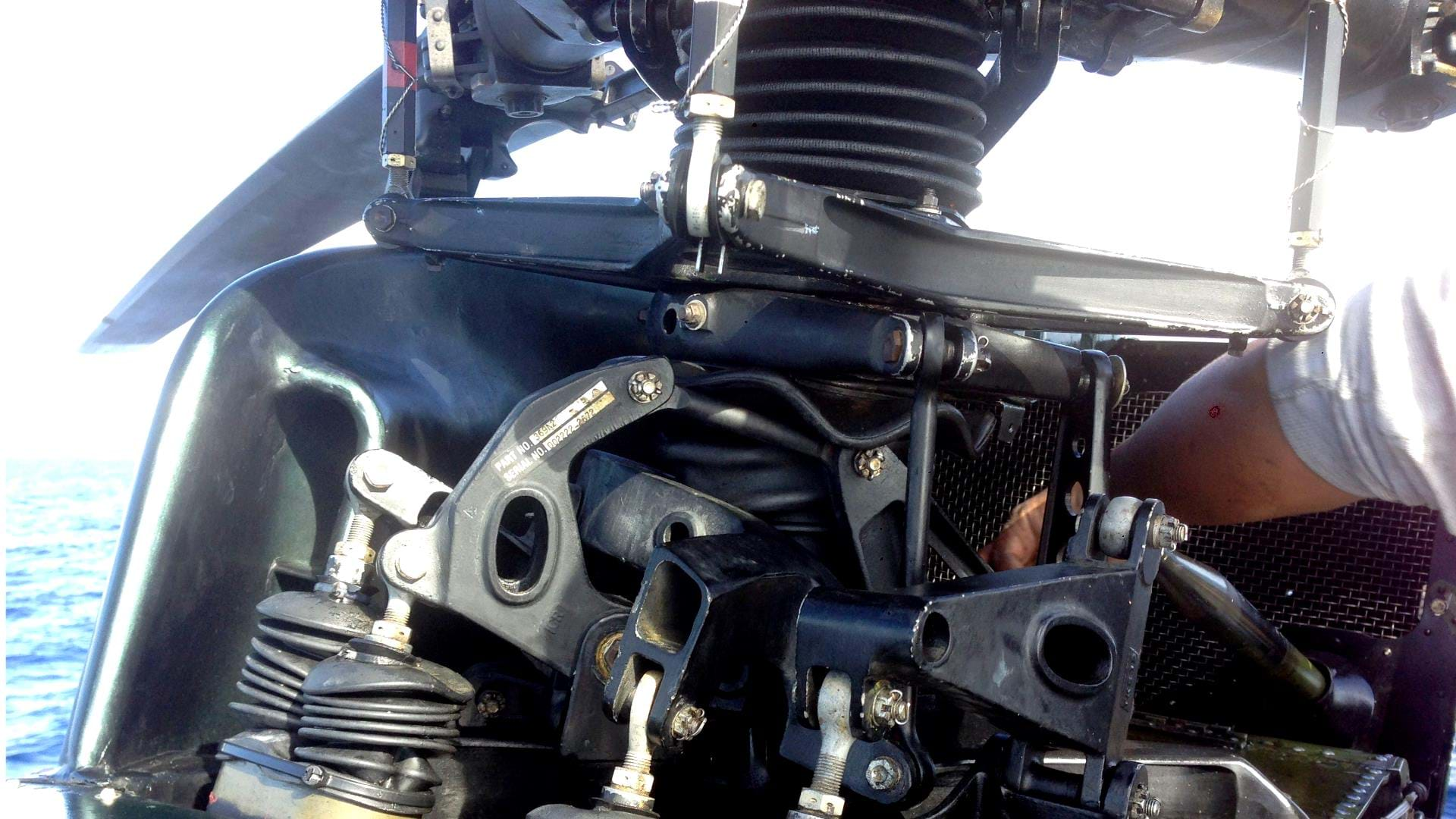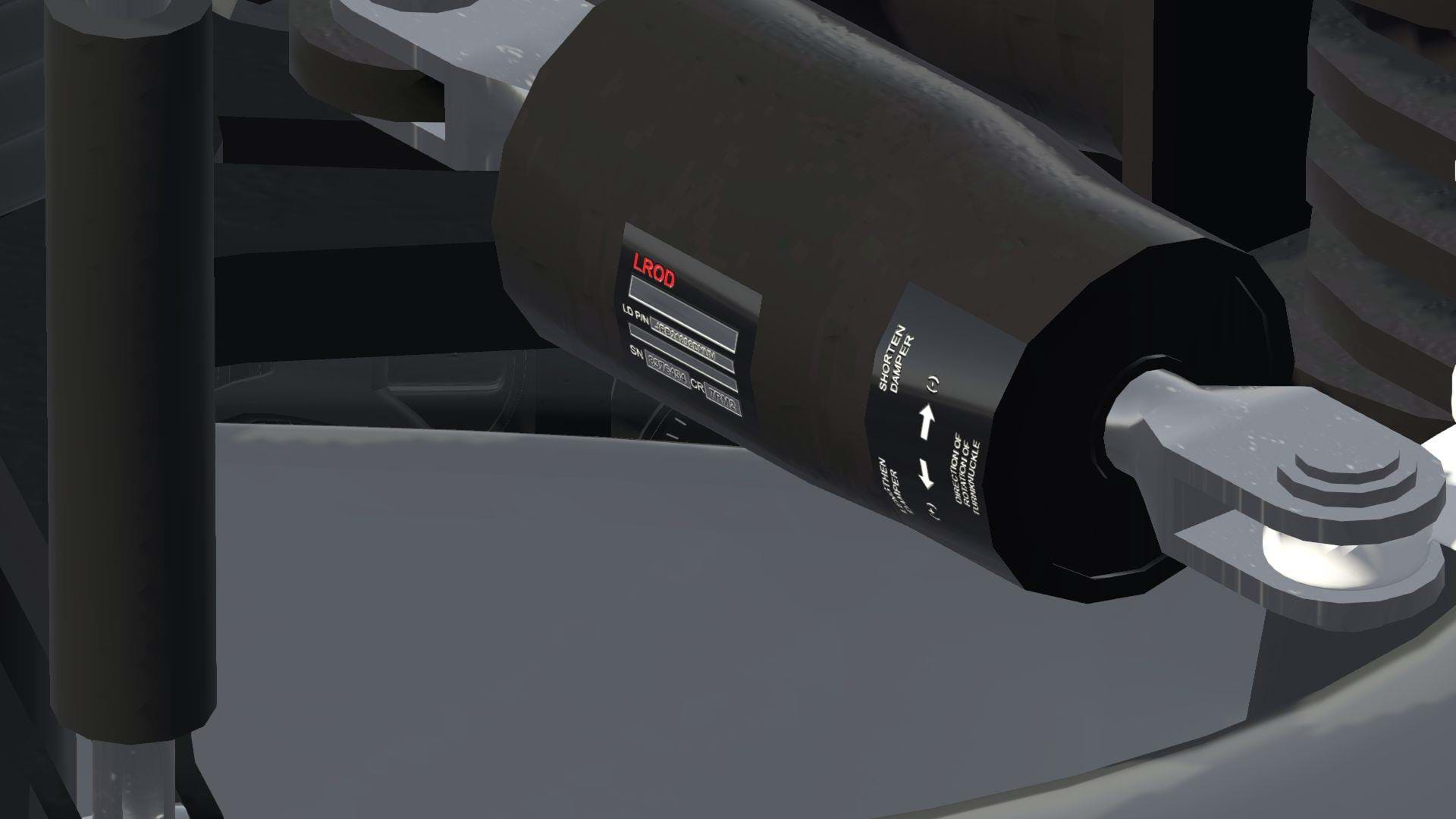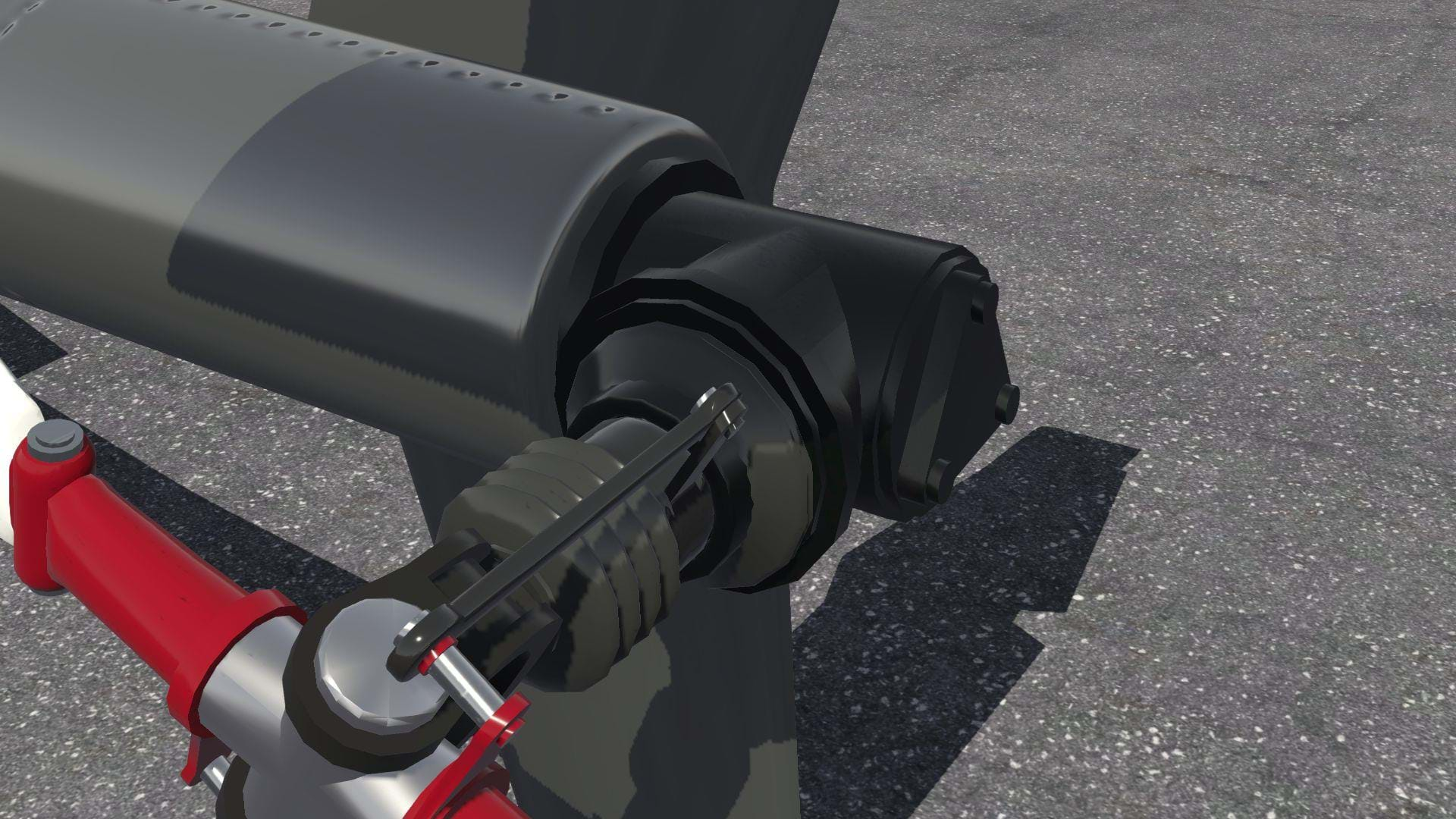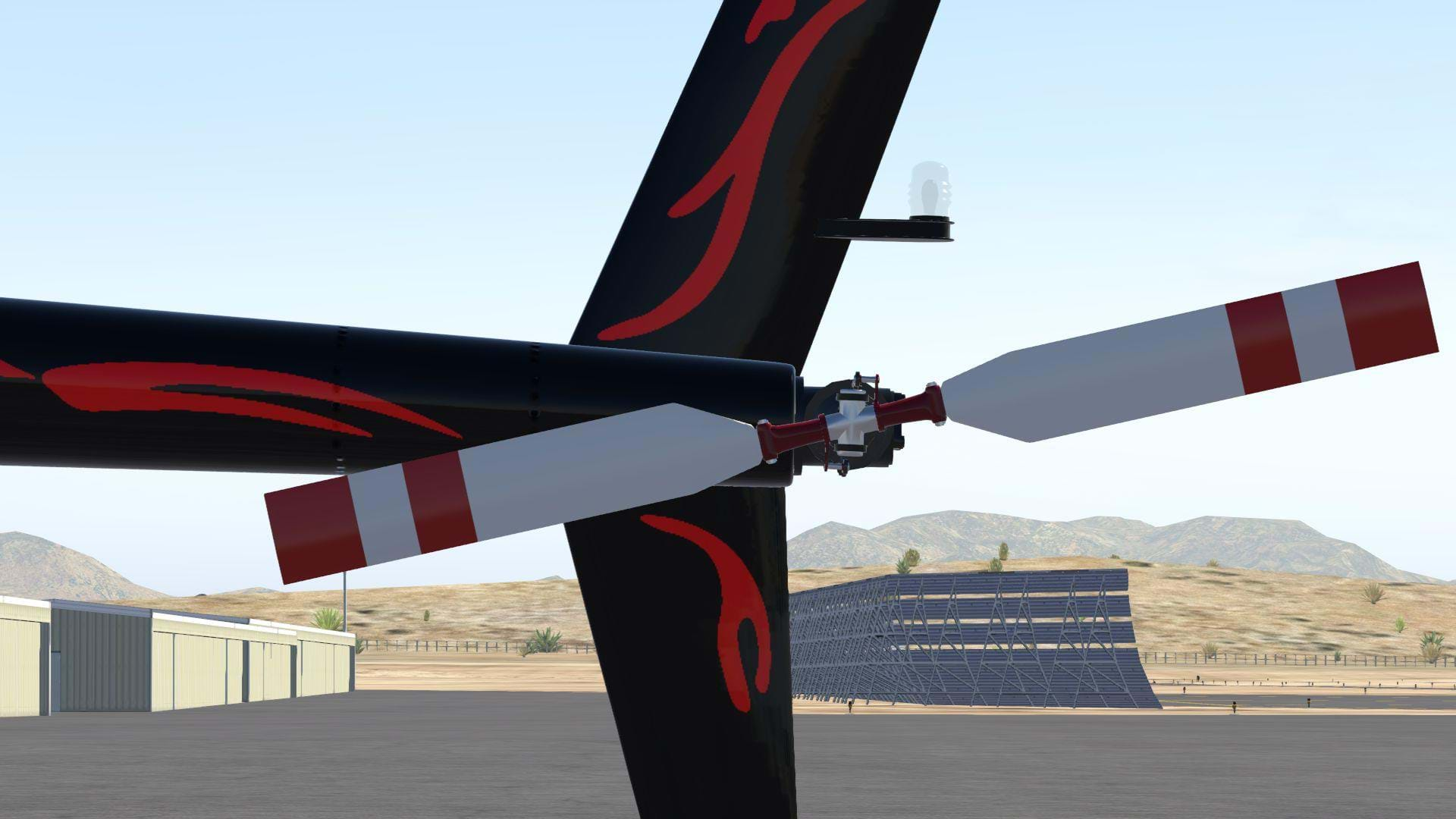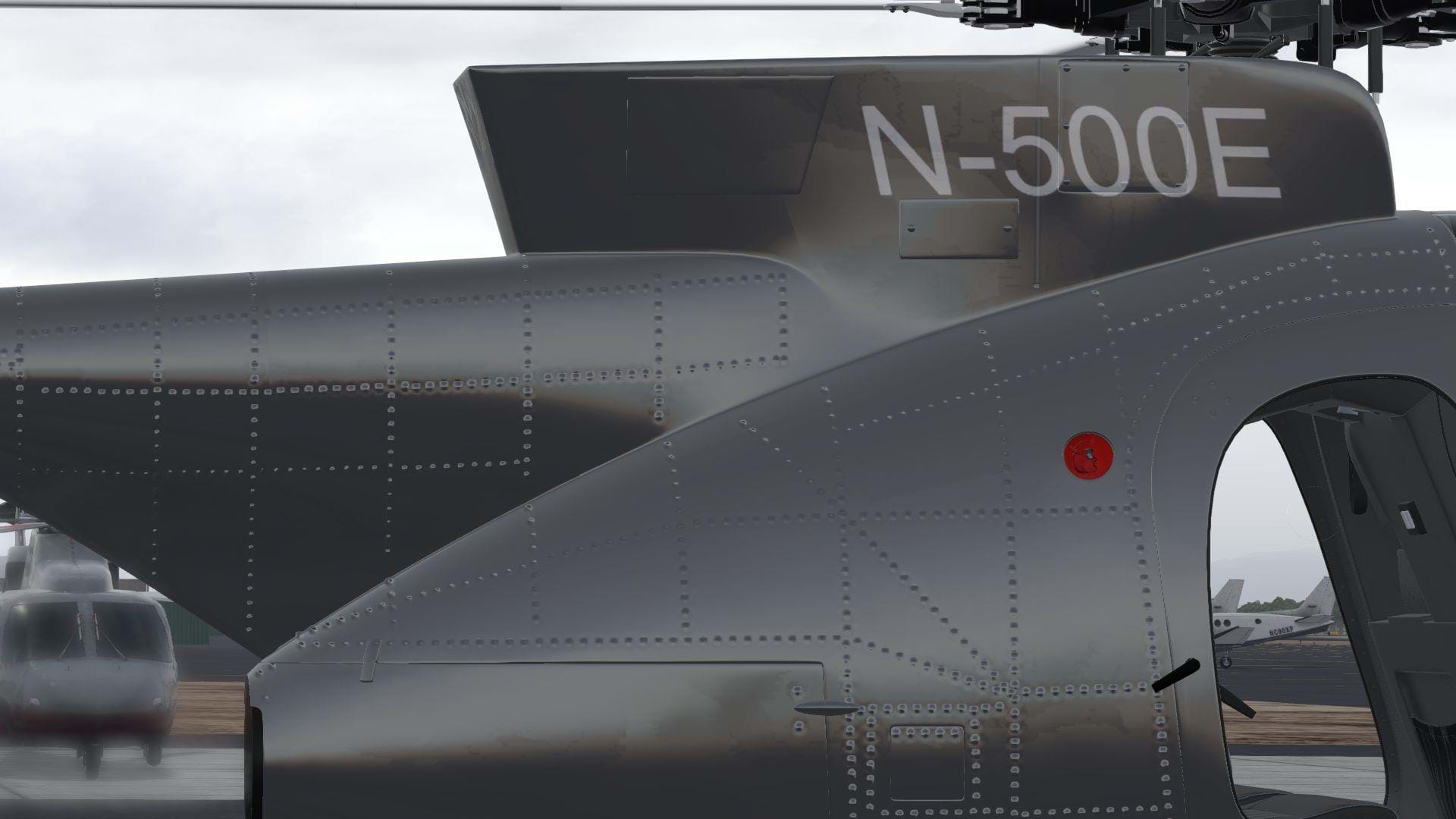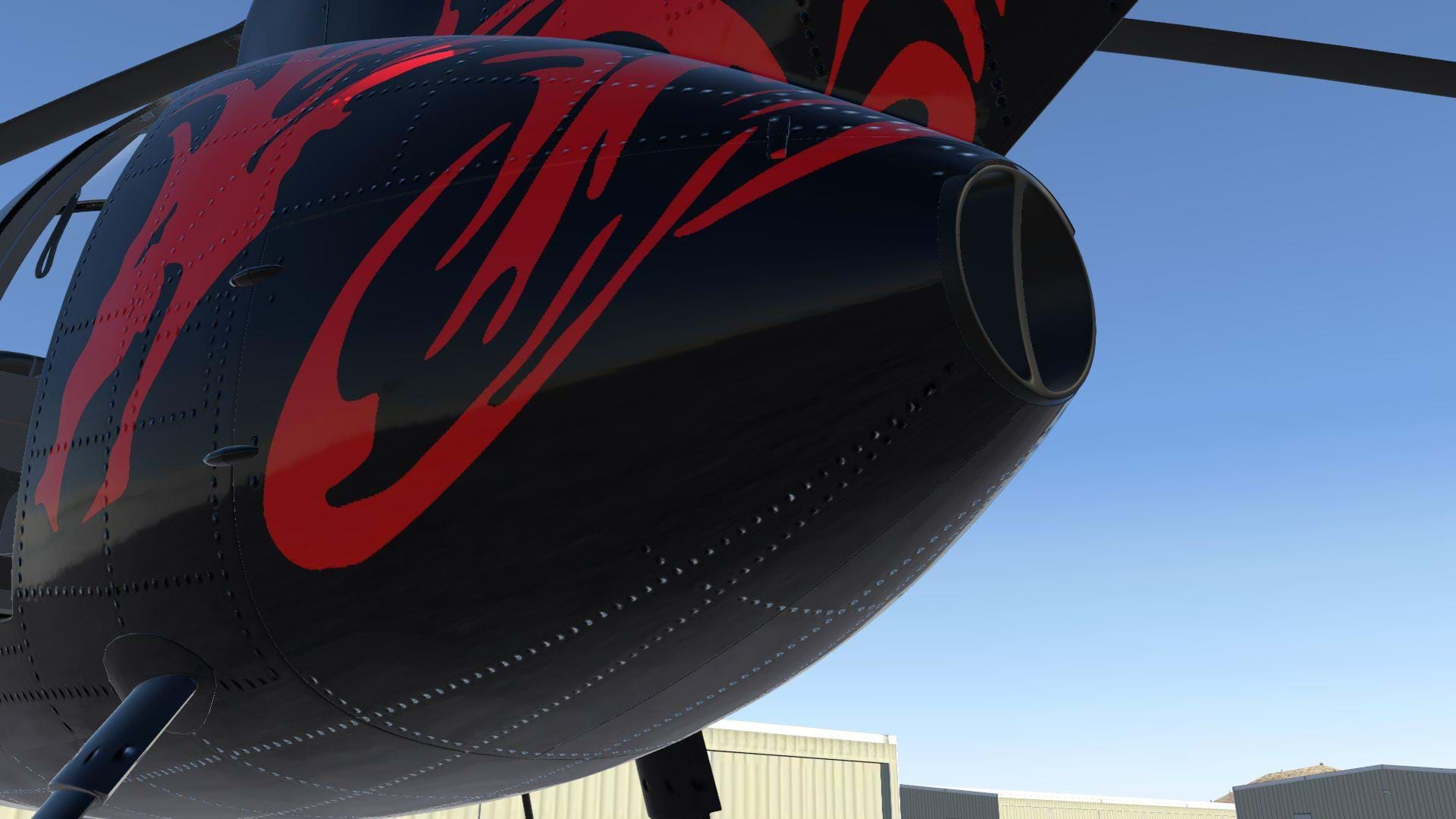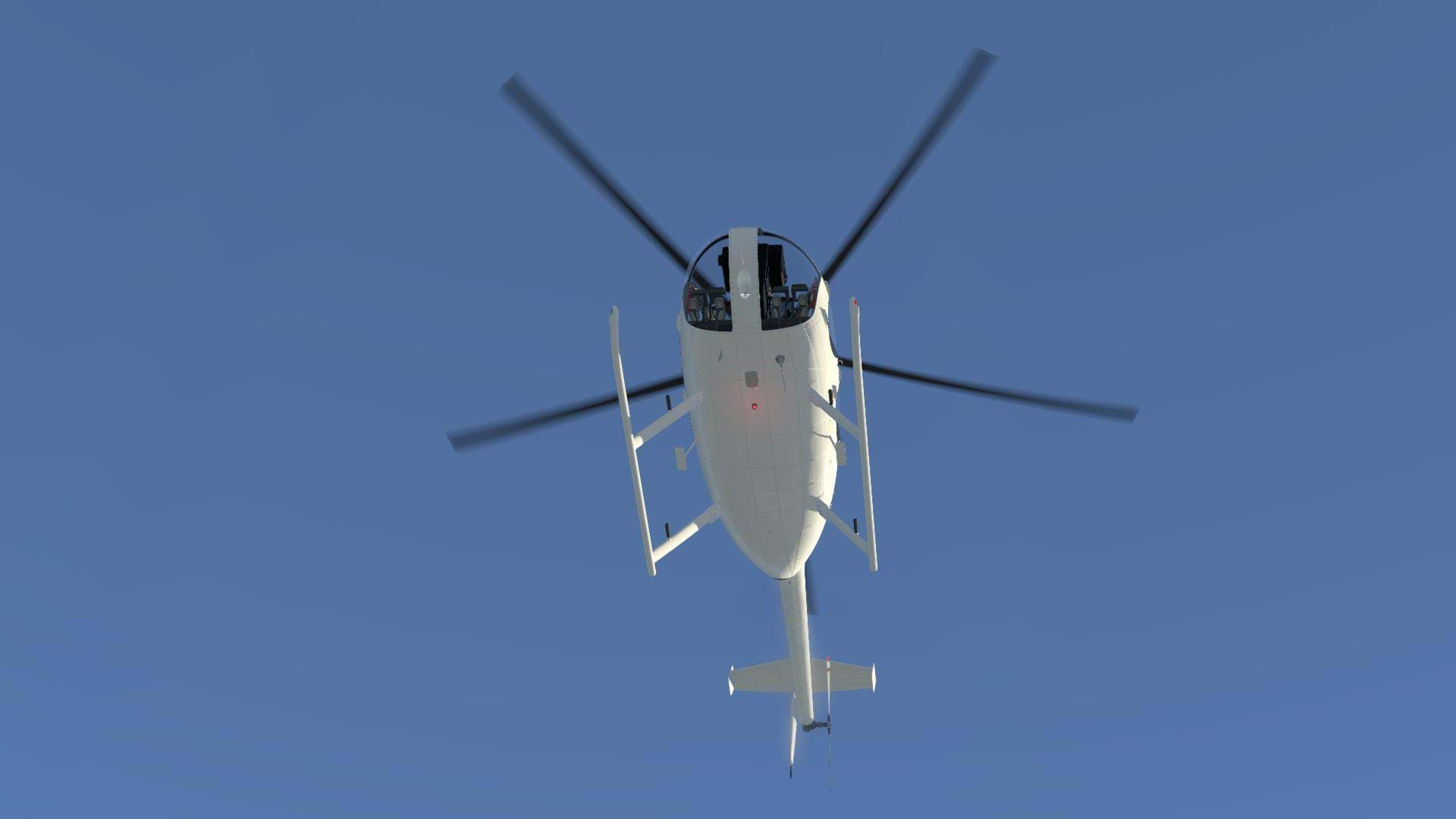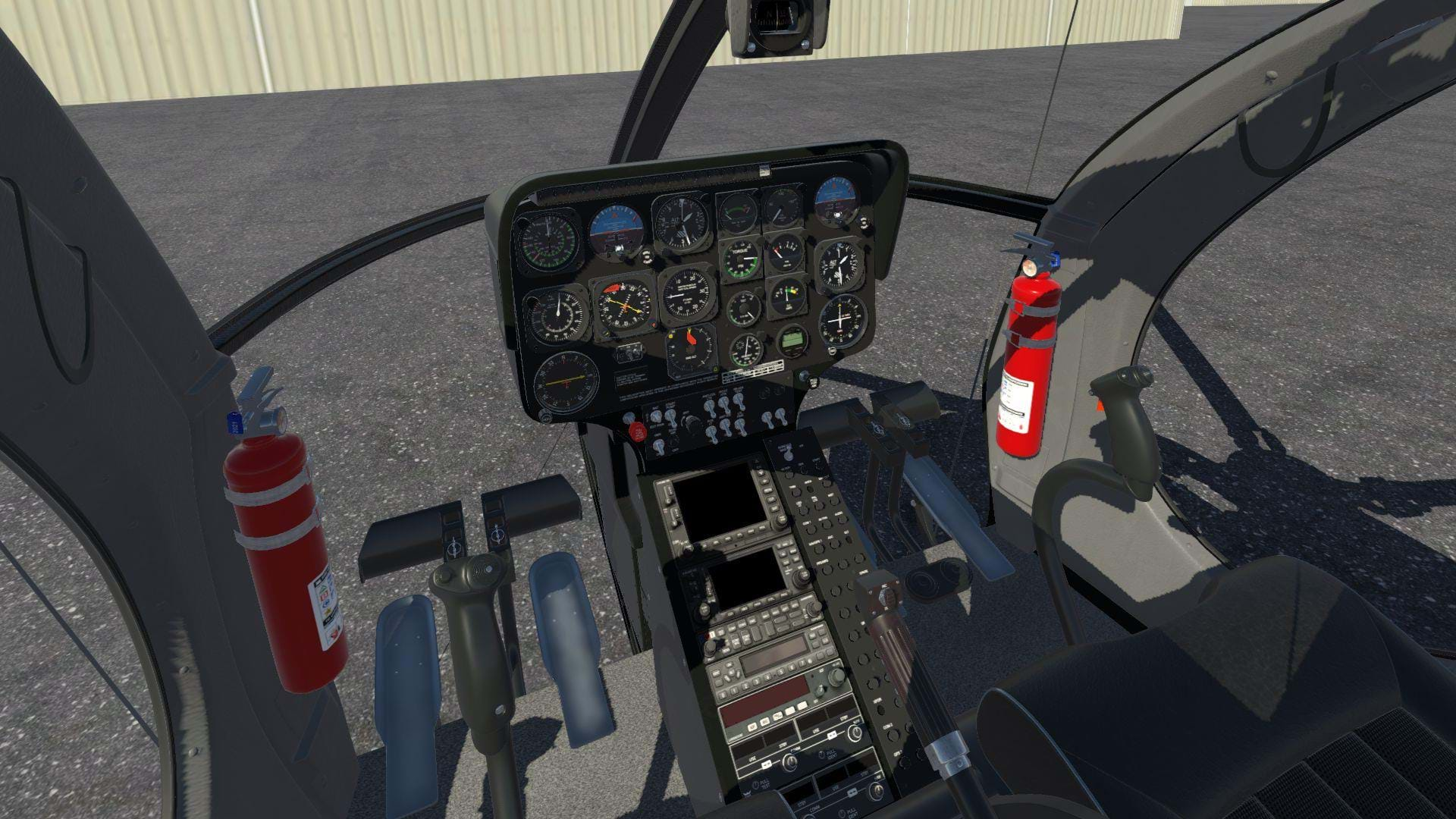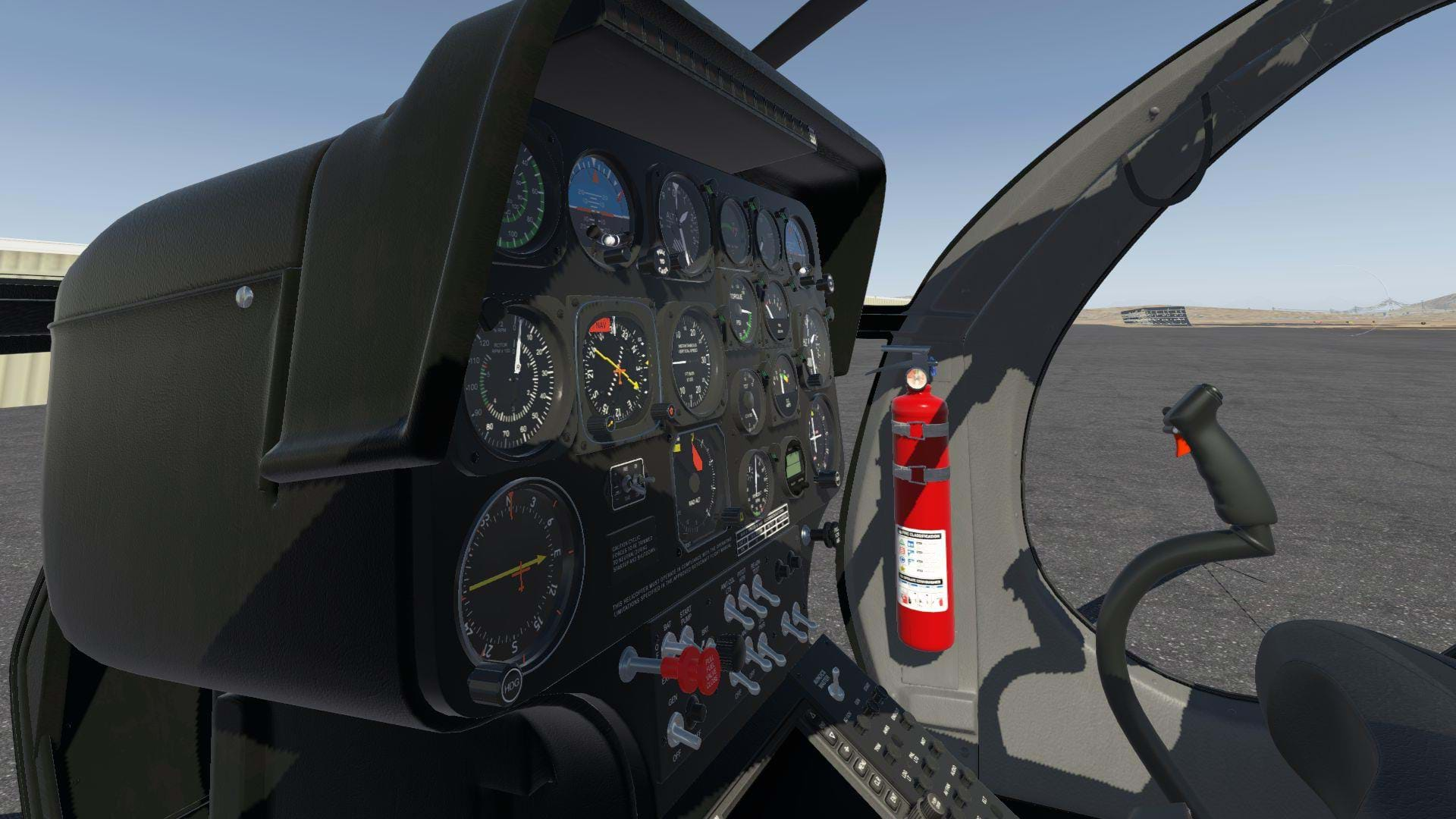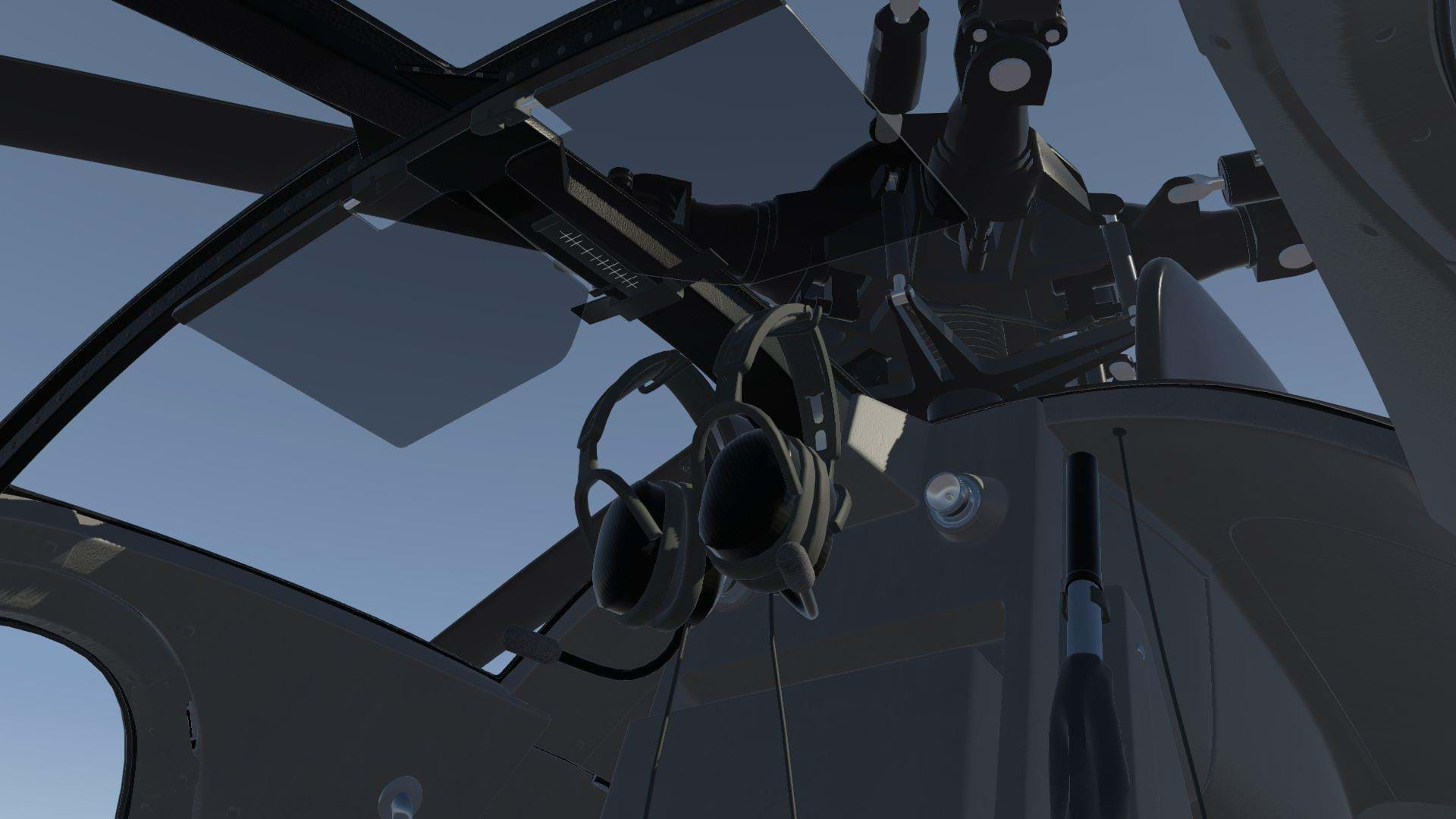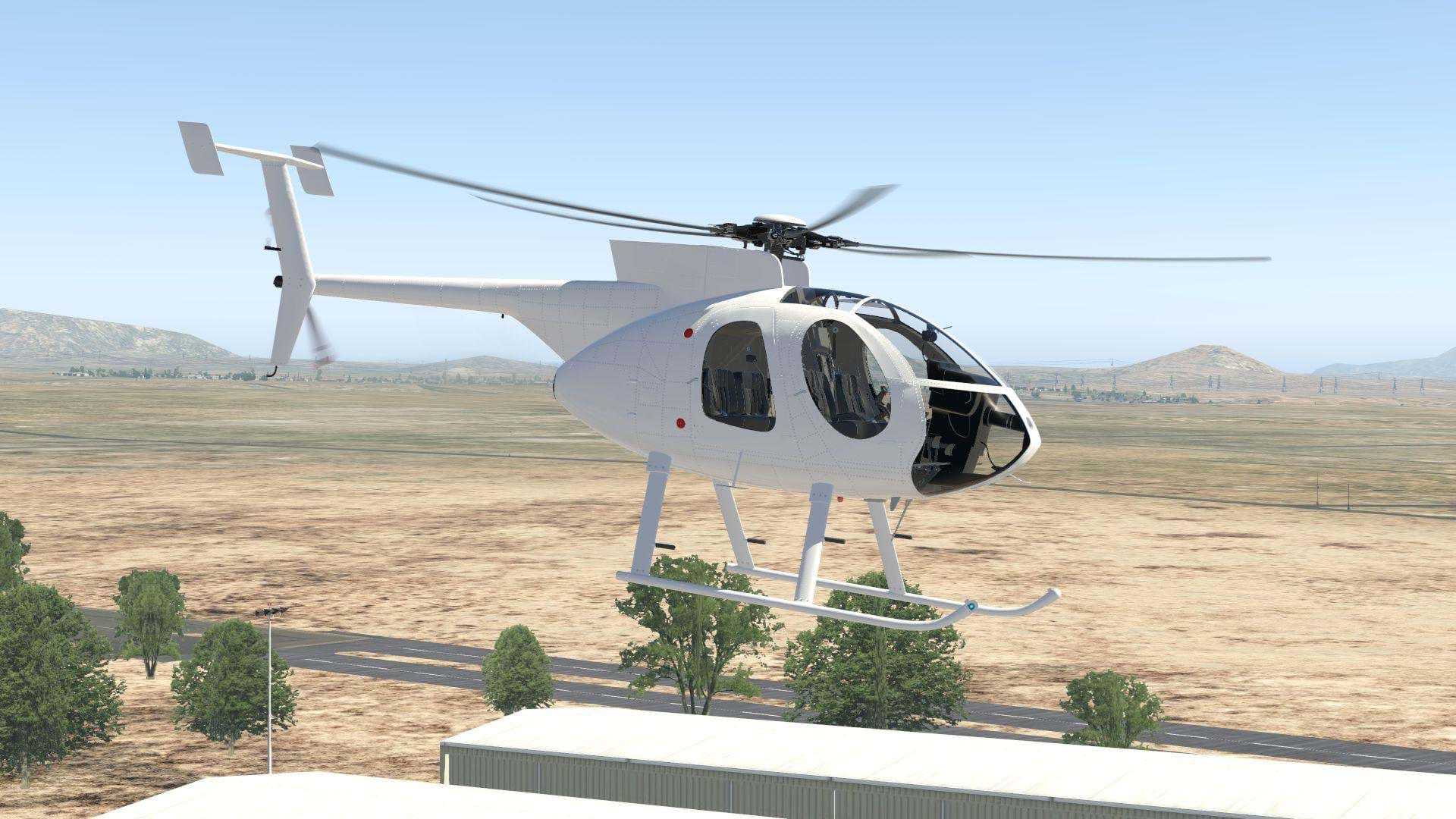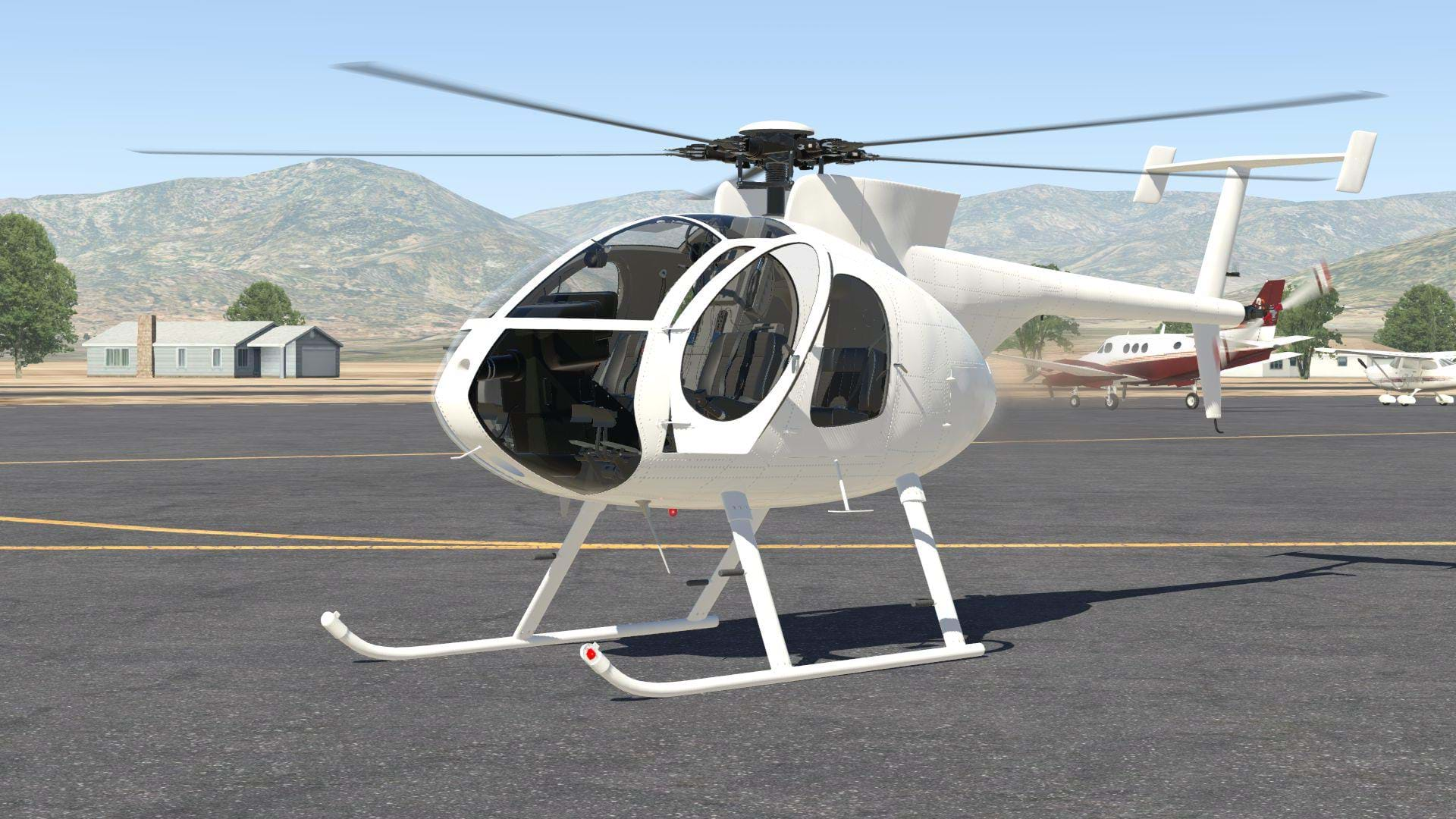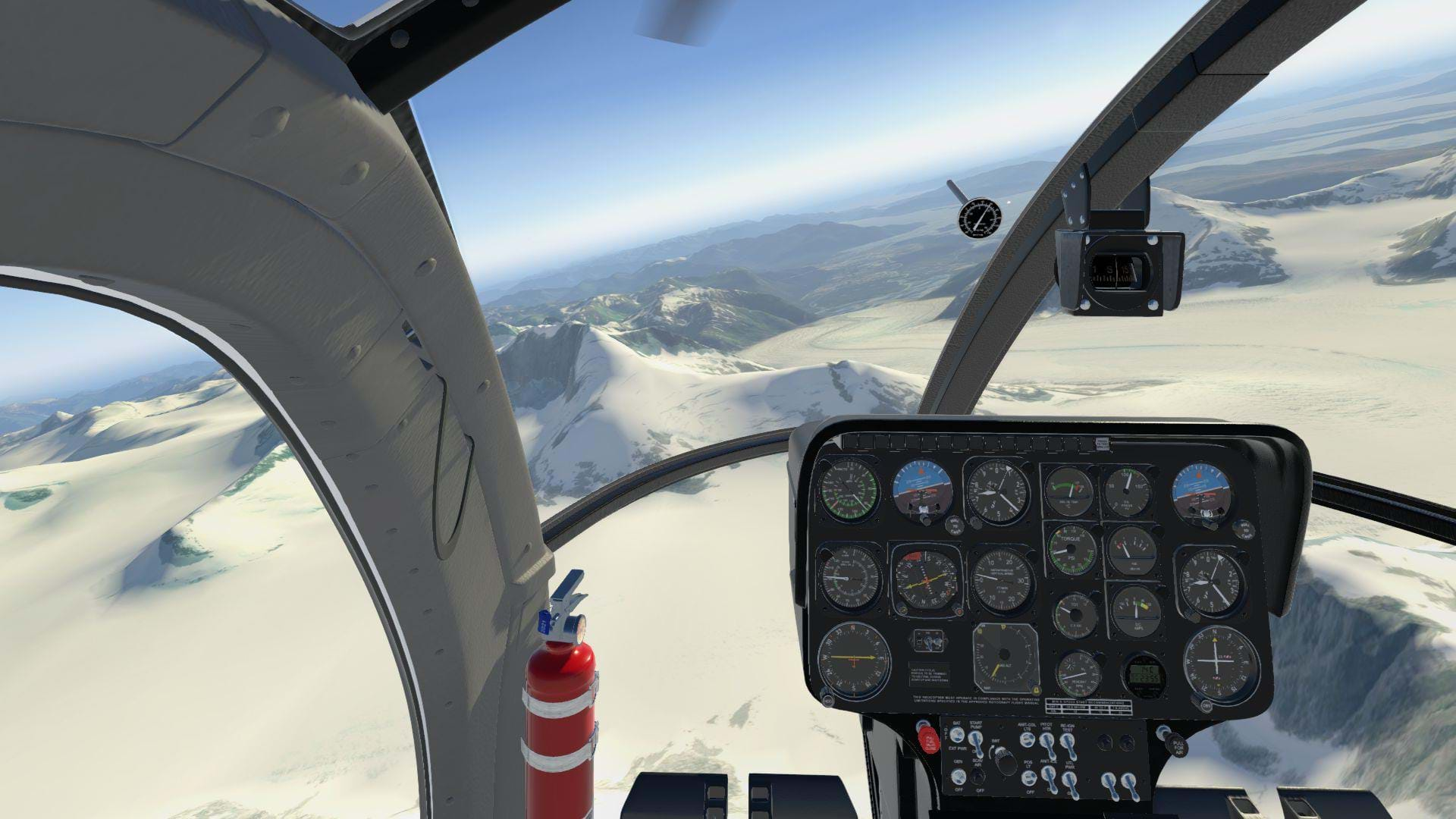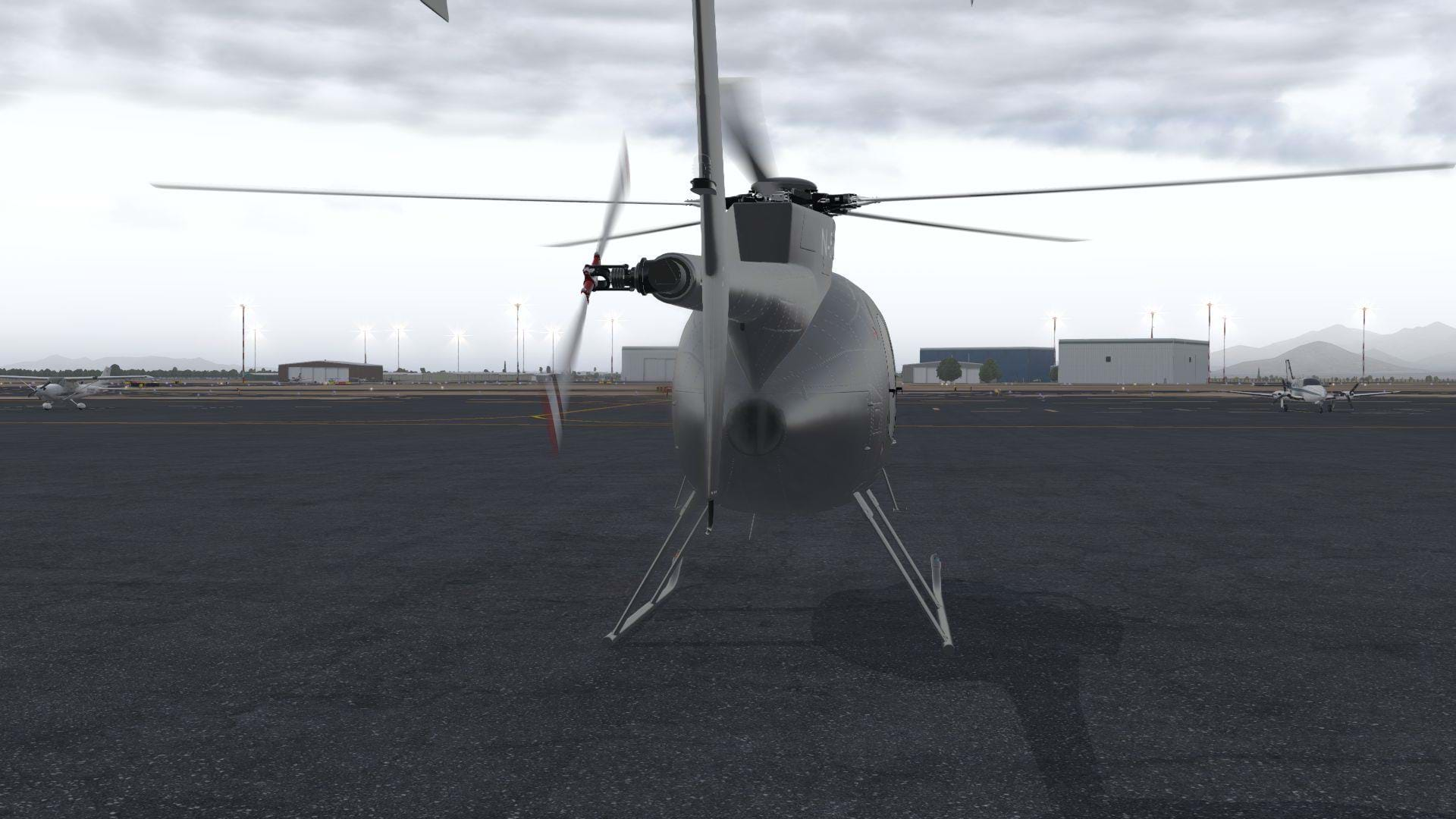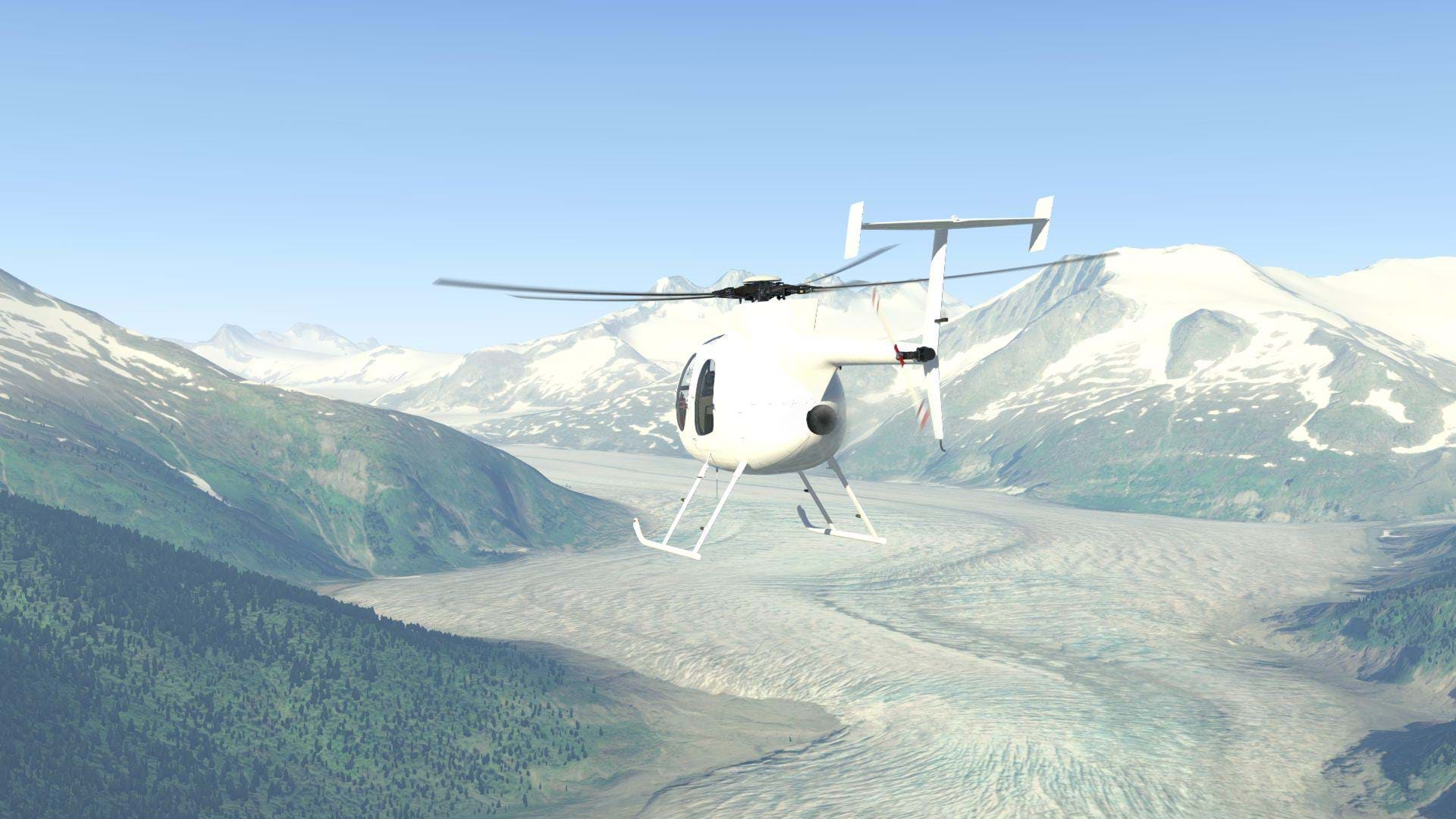Update - March 17, 2022
Nick wrote an update or an addendum to this review, which you can find here. You should read it after going through this review.
Note: A more comprehensive history of the Hughes 369 series was covered in the Milviz MD530 review.
In 1984, McDonnell Douglas acquired Hughes helicopters. Hughes had been building helicopters for the military since 1952 and for the civilian market since 1963 and the sale meant the end of the line for the helicopter company started by Howard Hughes.
Although McDonnell Douglas were a mover and shaker in the fixed wing world, they had no experience making helicopters and so the original Hughes helicopters H269 and H369 were continued by McDonnell.
In 1986, glider manufacturer Schweizer acquired the rights to the Hughes 269, producing it as the S300 while McDonnell continued to produce the existing models of Hughes 369s. Hughes had designed and built the E model in 1982 and it differed from the D by introducing the option for the larger Allison 250 C20R engine, much larger ‘T’ instrument panel, pointed nose and other minor cosmetic changes.
The E model cabin was also slightly redesigned to offer a marginal improvement in the rear seats although most people would agree that the rear seats on the 500 are still the worst places to be sitting, possibly in the whole aviation world.
The E was marketed as an Executive model however given what the aircraft was originally designed for, an executive fit was somewhat problematic. The E model didn’t sell anywhere near as well as the H and D model 369s, by now renamed the MD500, given that the aircraft were generally heavier to start with and offered little in the way of an performance improvement.
In addition the original H model fuel tank (242L / 403lbs) was still fitted meaning that the range and endurance with the progressively bigger engines was decreasing. Nevertheless, the E model did find a small niche of operators and to date, more than 600 have been built with the aircraft continuing to be manufactured alongside the more powerful (and more thirsty) MD530F and the unique MD520N.
Cowan Simulation MD500E
Cowan Simulation exploded onto the flightsim scene with their rendition of the Bell 222 UT and B models.
It was apparent to anyone watching that we had ourselves a dedicated, enthusiastic and engaging developer. As somebody with their ear to the ground when it comes to the 500 in simulators, the announcement just before release of the development of an E model caught me totally off guard and scrambling for the E model flight manual.
We were denied a good 500 for X-Plane for sometime until the freeware D model was released and the subsequent realism pack which I was fortunate to be involved with. Cowan Simulation have a hard act to follow to match the freeware offering.
Full Disclosure: I was not involved in any way in the development of this model, however, I have become involved since. This release is V1.0 and from the way that the Bell 222 went, we know that this isn’t a ‘fire and forget’ release. I suspect that almost all of the issues that I mention will be changed, fixed or corrected in subsequent updates. The developer is aware of everything that I have found while testing this release.
Download and Installation
The 500 can be downloaded from Cowan Simulation’s own website. There are two downloads available, one with 2k textures and one with 4k and they run at 429mb and 544mb downloads respectively.
Once downloaded, they are simply dropped into the ‘aircraft’ folder. Once uncompressed, they run at 976mb for the 2k version 1.06gb for the 4k. Within the sim as detailed in the manual, the throttle must be mapped to the ‘wing sweep’ command.
Model and Textures
I have more time in the 500 series than in any other type so far, so I am somewhat picky when it comes to these in the sim. Loading Cowan Simulation’s E in the sim for the first time had me excited. It looks really pretty all around.
All is not perfect by any stretch though, as is so often the case with the first version of things.
The first thing that stood out was the shape of the fuselage. There is something off about the line of the doors. Most people probably can’t tell but it looked off to me.
The other ‘big’ thing that stood out is the landing gear geometry. It looks like there is no weight sitting on the legs and I think the ship sits too level. In addition, the end caps on the horizontal stabilizer are too big, the tail rotor diameter is too large, the main rotor blade chord isn’t thick enough and the blades droop rather a lot at rest.
Possibly the biggest single issue with the external model though is the lack of mixing unit in front of the ‘dogbox’.
The control rods in the 500 all come up through the pillar between the front seats and into a mixing unit below the rotor head. There are two rods for the cyclic, one for the collective and one for the pedals. In all fairness, this wasn’t present on the freeware model either and it is quite an intricate thing to create but this being a new model, I personally think it should’ve been included.
The rotor head itself is really well modelled with the exception of the cyclic swashplate movement. The developer acknowledges that this isn’t finished though.
The texturing of the model is pretty crisp and detailed with some excellent work on the rotor head itself down to the data plates on the elastomeric dampers.
The other tail rotor components are reasonably well constructed and textured although, like a lot of other models, are missing a lot of the little details.
The fuel and oil caps are present however the fuel cap may be slightly too small and the oil cap, in addition to missing the accompanying sight glass is far too big.
The kick step is modelled on the right hand side of the fuselage as is the scav air door although there isn’t a lot of detail present and could do with a tweak. The model isn’t equipped with an air filter or particle separator.
The larger step that is common on the E is present on both sides. These act as two of the three jack points for the aircraft, the third being under the tail boom and this is also present.
The two exhaust halves are modelled although the divider is concave when it should be straight. The clamshell cowling latches are present however the one on the belly is missing. While under the aircraft, there isn’t a lot of detail in terms of drains and breathers but this is pretty minor. No cargo hook is present at this stage.
The cockpit includes the standard ‘T’ panel that was introduced on the E model and the not so standard large avionics cluster favoured by Police and paramilitary operators that makes the use of the middle seat problematic.
The cockpit is largely functional but a few of the switches are not modelled yet. The biggest inaccuracy is the key that is on the side of the panel for engaging the start relay is missing. A bit of an error on the developer’s part that they are aware of and will be modelled in a future update.
None of the bleed air devices or scav air equipment are modelled yet however, again, this will be included later.
The controls are nicely modelled although the shape of the cyclic grip is a little wrong and the collective mounting point is inaccurate, however, you’re not going to see the base of the collective very often.
There is a now standard rotor brake modelled in between the seats and headsets hanging from the roof along with sun visors that to be honest, I’ve never seen on the real thing but it might be a feature although they doesn’t appear in the MD literature.
No pilot figure is present yet but as with the Bell 222 this is to be added at a later date. Two fire extinguishers are present, mounted to the side of the cockpit next to the doors. Only one is usually present however Cowan Simulation have made the one on the right side optionally hidden with a click spot.
The modelling of the rear compartment while simple is wholly accurate and gives some of the claustrophobic feel of the real thing.
The soundproofing, instrument panel combing and seats are well textured, when it comes to shadowing and are overall quite convincing. I would however like to see some more detailed texturing on the cyclic.
There are push out air vents on the doors however, they don’t move and they have no depth so you wouldn’t know they were there.
With the engines running, the rotor head animation is very convincing from the outside, a little less so on the inside but that is definitely a balancing act.
The two main issues with the animations are that the blades cone up with flat pitch which they shouldn’t do and too far too much when flying, and the tail rotor animation makes it appear as though it’s rotating far slower than it should be.
Cowan Simulation has included blade tie downs for when the aircraft is at rest. I’m hoping that more covers can be added later but this is a good start.
Overall, there is definitely room for improvement in most areas here. Developers have to make big decisions as to how far down the rabbit warren they are prepared to go to deliver a realistic product.
A lot of the inaccuracies here are probably pretty minor to most people and have only been picked up by me because of my familiarity with the real thing. Given the developers track record thus far, I would suspect that most of the issues will be fixed at some stage.
I haven’t written much about the texturing because there isn’t much to say. It’s pretty damn good. Room for improvement in some of the little details but that’s nearly always the case.
Systems
Although it is getting on in years now, the 500 series is still a very simple aircraft and this is part of the appeal for pilots.
The original mission for the 500 was for the US Army and in the mid 60s, that meant of course, Vietnam. The Vietnam era OH6s which was the original military designation for the aircraft were crewed by a pilot on the right, an observer on the left and a crew chief in the rear.
The aircraft was simple enough that the crew chief with a set of hand tools could do all of the daily servicing without the need for stands or any other large equipment. In fact, it is possible for an engineer with some training and knowledge, to change out an engine on the 500 by himself in a single day in the field.
Cowansim acknowledge that as of right now (v1.0) the 500 uses custom systems integration but is in no way finished.
This means that there are going to be inaccuracies in the way that the systems behave at this stage. This presents a problem for the reviewer. However, I must judge it as it stands and by the same standards by which I judge everything else.
The battery switch which is supposed to be a three position for battery and external power is only two position right now.
Placing it in the ‘Battery’ position brings up all of the systems and appropriate warning lights. The generator switch activates the engine out horn and the reignition test sets off the ignitor however it doesn’t activate the test light on the panel like it should.
One big omission at this stage is the lack of the key which was moved on the E model from the front of the panel to the side. The key activates the starter relay which lives in the engine compartment and as the name would suggest, allows you to start the aircraft.
The throttle has the correct idle stop collar that works as it should. The N2 beeper switch is present and I was able to ‘beep’ the RPM but it had to be held down with the switch rather than setting it.
There is no low RPM light or horn when it’s at the bottom of the range. There are no control frictions or locks as there are on the real aircraft however, in all fairness, a lot of addons don’t have this feature. The cyclic trim works as it should although there isn’t any sound associated with the motors.
The avionics is on its own bus with an avionics master switch. This defaults to on when loading the aircraft so you have to turn it off before starting.
The aircraft is equipped with dual default GPS with the option for the 750 for those who have it, transponder which has no brightness, ADF which doesn’t seem to work unless you start with the engines running, and a host of nav radios.
Both GPS units have the comm radios but there are two more comm radios down the bottom of the panel that don’t have any audio in or out on the audio panel. In short there are more radios than the audio panel can handle. Along the side of the avionics panel are the circuit breakers, none of which work.
The fuel shutoff valve is functional although it defaults to the cut-off position when the aircraft is loaded. The utility power switch is present although non functional of course and the scav air switch is blanked as for a machine without the filter fitted.
The engine instruments behave as one would expect without custom coding so I won’t go on and point out all of the inaccuracies, suffice to say that these will be corrected as time goes on. The one thing that I will say is that hitting the starter will take N1 to nearly 20% regardless of whether you hold the button down or not.
The warning lights activate more or less as they should with the exception of the aforementioned engine out and reignition lights. The points at which the transmission oil pressure light comes on also needs some tweaking however, the basis is there.
The single 242L fuel tank is modelled and although the capacity is correct, the fuel burn is a long way off. The endurance as listed in X-Plane’s Weight, Balance and Fuel window is over five hours with a full tank. In reality a C20R powered E model will be on the low fuel light after two hours depending on what operations it’s been used on.
As you can see, there is plenty to improve on here. For a more realistic simulation of the 500 series systems, the freeware D model might be a better bet right now however I fully expect Cowan Simulation to improve on all of this over time and I think we’ll see a far more comprehensive simulation of the MD500.
Sounds
Sounds are one of the hardest things to get right in an addon and poor sounds can totally kill the immersion. The MD500s sounds is made up of three distinct types of noise. On the interior, the overriding sound is the main rotor transmission, which sits right behind the pilot’s head. On the outside, the tail rotor accounts for a majority of the external noise.
This has actually been an issue for operators in various parts of the world, a four bladed tail rotor is available for the D, E and F series. This adds another set of two blades, new yoke and a slowed down tail rotor gearbox. This reduces the noise signature of the aircraft by quite a lot however it also makes the aircraft feel ‘doughy’. The other noise is the main rotor blade ‘slap’ which is quite different to the blade slap on most other helicopters.
Virtually everything in the cockpit of the Cowan Simulation 500 makes noise including the doors and rotor brake which is a nice surprise!
Moving the controls while the aircraft is shut down doesn’t produce any noise but neither has any other 500 in a sim. One of the little things that is missing is the sound of the push to test on the warning lights when the battery is off. Clicking on the pilot headset muffles the sounds.
Hitting the battery switch, you can hear gyros and avionics fans winding up. The sound is pretty good with no gaps or looping.
The sound winding down when you kill the battery power is a little short and abrupt but it’s not terrible. The engine out warning is present however it does need to be louder given that it’s supposed to get your attention. The start pump makes noise however I think it’s a X-Plane default pump sound and not the type of noise that the fuel pump makes.
The switch sounds themselves are the same throughout and the only improvement that could be made here is for them to be ‘softer’ to match the type of switch that is modelled on everything except the battery.
Hitting the starter produces some sort of start-up sound however it isn’t very clear, almost a muffled noise.
The initial starter noise is one sound that spools down again even if you’ve lit the engine off. Completing a normal start cycle, the transmission whine inside isn’t anywhere near shrill enough.
Outside, it seems to be an odd mix of noise that doesn’t really sound much like a 500 until you wind the throttle open when some tail rotor buzz comes in. Sitting inside at flight idle is more or less the same noise as at ground idle. With the door open, the mix between interior and exterior is about right.
In flight, there isn’t any of the ‘growl’ that the 500 gets when in a turn or descent. The sound in auto is the right sort of mix but of course, the sounds themselves aren’t right.
Unfortunately, the sounds here just aren’t very good right now however I have absolute confidence that they will improve with time. What is encouraging is the cockpit sounds for the switches etc is quite comprehensive.
Flight Dynamics
I converted onto the 500 in 2010 and I’d only flown Robbies and the Hughes 300 beforehand. The 500 wasn’t a particularly big jump after flying the 300 apart from the size and speed of the aircraft. Getting used to it being on the ground from such a high seating position gave me some embarrassing moments later on when going back to flying the R22…
There are a couple of characteristics of the 500 that you really notice when flying it, especially after things like Robinsons.
First off, you use a lot of the controls, particularly the pedals. The 500 has a fully articulated rotor head which lends itself to stability so to get it to move, you have to make it do so. It also has a short coupled, high speed tail rotor. What this means is that it needs a lot of pitch to achieve the desired anti torque. When you fly 300s and 500s for the first time, you feel like you’re pushing the left pedal through the bubble.
Picking Cowan Simulation’s E up into the hover, the first thing that I noticed was that I wasn’t using a lot of left pedal.
Now the aircraft can be rigged like this if you’re using them to do a lot of slinging and don’t want to be pushing on that pedal all day however, you then have to have a heap of right pedal in during low power situations and this isn’t the case with the model.
The other quite noticeable thing is that the real machine will sit quite left skid low in the hover due to the torque couple set up between the main and tail rotors. This is present on the model but not as much as it should be.
I was very impressed however by the way that the aircraft felt very stable in the hover and yet nimble at the same time! This was a great relief as it seems some developers aren’t able to replicate this.
Going through into forward flight was pretty smooth and normal however, the climb rate at MAUW of 3000lbs seems a little excessive.
When in straight and level flight, it doesn’t seem to accelerate when empty and it takes a long time to get to 100kts but the descent is where I noticed the biggest issue. No matter what the weight the aircraft does not want to descend and decelerate at the same time.
It floats like crazy and then drops out of the sky when it gets back to around 35kts. If you do long slow approaches, you don’t really notice the issue but roaring around close to the ground trying to stop it quickly always gives me issues.
In addition to the lack of left pedal, there isn’t a lot of need for right pedal at speed in the cruise. This is something that a few helicopters suffer from in the sim. Flying it point A to B is comfortable and easy just like the real thing.
Taking the E model to Juneau Alaska, my usual mountain testing area, I tested the altitude performance. I was able to hover IGE (In Ground Effect) with a OAT of 17 degrees C at 7000ft AMSL…. JUST. TOT and Torque gauges are below the limits but the N2 drops below 103% there.
According to the charts from the Rotorcraft Flight Manual, in the same conditions, one SHOULD be able to hover IGE at around 8500ft (I didn’t print the graph out and use a ruler to get a precise measurement).
After speaking with Cowan Simulation, it appears that some incorrect numbers were entered during creating the flight model so expect this to be fixed.
Back to sea level more or less for some auto testing. Entering from 1000ft AGL I am finding that bringing the speed back to 65 to 70kts while trying to contain the RRPM in the green band means that the rate of descent is only around 1200fpm which is pretty low.
That’s with the aircraft at MAUW. Take all of the weight out of it and the same conditions produce a ROD of a little less than 1000fpm. I am finding that the RRPM is incredibly hard to contain within the limits, a minute movement on the collective can set up for a huge overspeed or the RPM dropping through the floor. The real thing is very much more stable in auto.
Flying in the wind produces the usual X-Plane driven results where the aircraft won’t flick in a tailwind and all of that stuff. The 500 is very controllable in some quite strong winds, I hovered a C model in a 40kt crosswind once without too many issues, but you have to be assertive with the pedals to make the aircraft do what you want. Unfortunately X-Plane doesn’t model this very well.
The flight model on this really needs some tweaking. The base is there but there are some big changes needed to make it fly like the 500. Thankfully, it is stable and you can fly for long periods comfortably. In discussions with Cowan Simulation, they are aware of the issues and are actively working to fix them.
Miscellaneous
Documentation
Two PDFs are included with both the 2k and 4k version. The manual itself consists of 12 pages and covers all of the little nuances that might trap people.
The second is a checklist covering start-up to shutdown. Both are clear and well written but I have found them less comprehensive than the Bell 222 manuals that came before.
Stick Vibration
As the rotors begin to turn, the stick begins to shake as it does in the real thing if you have the frictions released. The effect is quite good and pretty similar to what I remember from flying the real bird.
Liveries
Each of the versions of the 500 contain nine liveries including the all-white paint kit. Of those nine, three appear to be modelled after real aircraft. The paint kit is well designed and should prove easy to use for those with the talent.
[Editor’s note: Cowan Simulation’s next update will bring 50+ liveries]
Summary
The release of this came out of nowhere and caught me by surprise.
I am happy that it was Joshua Cowan that tackled this one as I know how receptive he is to suggestions and constructive criticisms.
There is a lot to improve on here and I do wish that the project was put out for some more testing prior to release. Thankfully, the project has met with widespread support and this will help make it grow. I know that updates are already in the works, so I think that it’s onward and upward from here.

